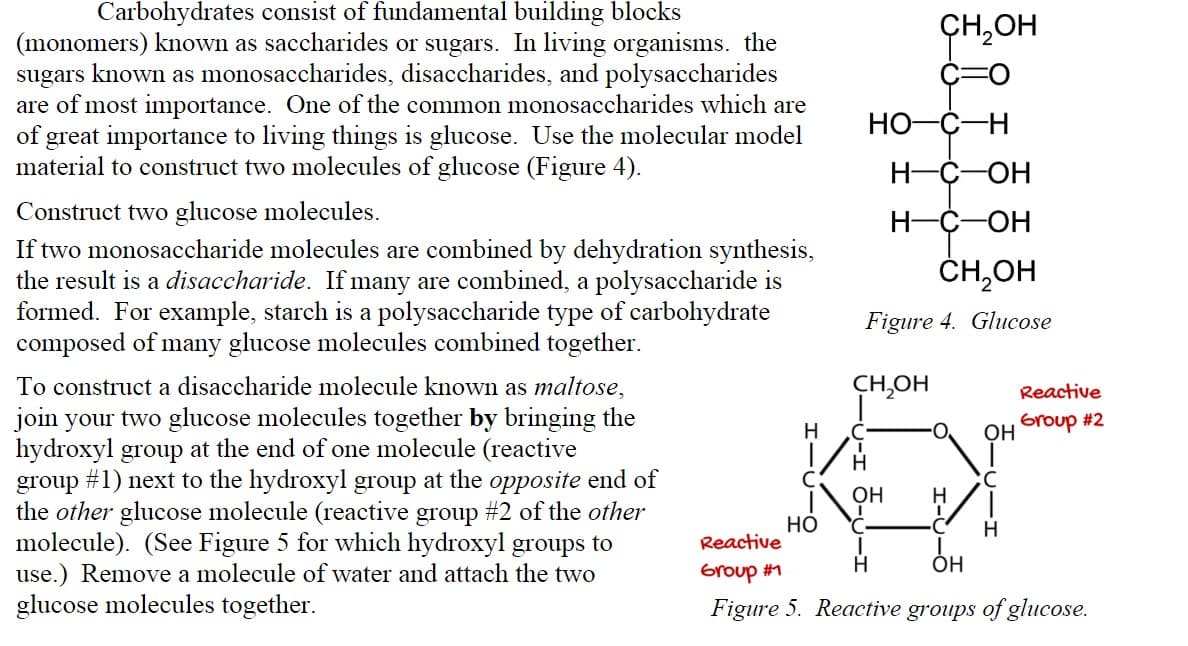1.A molecule of ______________________had to be removed to form a disaccharide? 2.The splitting of polysaccharides or disaccharides into monosaccharides reverses the processand requires the addition of the above molecule. This process is called: __________________
1.A molecule of ______________________had to be removed to form a disaccharide? 2.The splitting of polysaccharides or disaccharides into monosaccharides reverses the processand requires the addition of the above molecule. This process is called: __________________
Chapter3: Molecules Of Life
Section: Chapter Questions
Problem 5SA: Unlike saturated fats, the fatty acid tails of unsaturated fats incorporate one or more ________. a....
Related questions
Question
1.A molecule of ______________________had to be removed to form a disaccharide?
2.The splitting of polysaccharides or disaccharides into monosaccharides reverses the processand requires the addition of the above molecule. This process is called: __________________

Transcribed Image Text:Carbohydrates consist of fundamental building blocks
(monomers) known as saccharides or sugars. In living organisms. the
sugars known as monosaccharides, disaccharides, and polysaccharides
are of most importance. One of the common monosaccharides which are
of great importance to living things is glucose. Use the molecular model
material to construct two molecules of glucose (Figure 4).
CH,OH
HO-C-H
H-C-OH
Construct two glucose molecules.
If two monosaccharide molecules are combined by dehydration synthesis,
the result is a disaccharide. If many are combined, a polysaccharide is
formed. For example, starch is a polysaccharide type of carbohydrate
composed of many glucose molecules combined together.
H-C-OH
ČH,OH
Figure 4. Glucose
CH,OH
To construct a disaccharide molecule known as maltose,
join your two glucose molecules together by bringing the
hydroxyl group at the end of one molecule (reactive
group #1) next to the hydroxyl group at the opposite end of
the other glucose molecule (reactive group #2 of the other
molecule). (See Figure 5 for which hydroxyl groups to
use.) Remove a molecule of water and attach the two
glucose molecules together.
Reactive
H
Group #2
OH
C
OH
H
но
Reactive
H
Group #1
OH
Figure 5. Reactive groups of glucose.
Expert Solution
This question has been solved!
Explore an expertly crafted, step-by-step solution for a thorough understanding of key concepts.
This is a popular solution!
Trending now
This is a popular solution!
Step by step
Solved in 2 steps

Recommended textbooks for you


Biology Today and Tomorrow without Physiology (Mi…
Biology
ISBN:
9781305117396
Author:
Cecie Starr, Christine Evers, Lisa Starr
Publisher:
Cengage Learning

Anatomy & Physiology
Biology
ISBN:
9781938168130
Author:
Kelly A. Young, James A. Wise, Peter DeSaix, Dean H. Kruse, Brandon Poe, Eddie Johnson, Jody E. Johnson, Oksana Korol, J. Gordon Betts, Mark Womble
Publisher:
OpenStax College


Biology Today and Tomorrow without Physiology (Mi…
Biology
ISBN:
9781305117396
Author:
Cecie Starr, Christine Evers, Lisa Starr
Publisher:
Cengage Learning

Anatomy & Physiology
Biology
ISBN:
9781938168130
Author:
Kelly A. Young, James A. Wise, Peter DeSaix, Dean H. Kruse, Brandon Poe, Eddie Johnson, Jody E. Johnson, Oksana Korol, J. Gordon Betts, Mark Womble
Publisher:
OpenStax College

Human Biology (MindTap Course List)
Biology
ISBN:
9781305112100
Author:
Cecie Starr, Beverly McMillan
Publisher:
Cengage Learning

Concepts of Biology
Biology
ISBN:
9781938168116
Author:
Samantha Fowler, Rebecca Roush, James Wise
Publisher:
OpenStax College